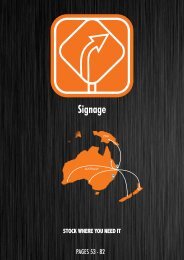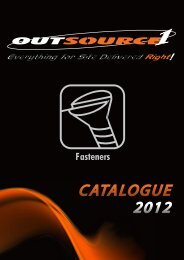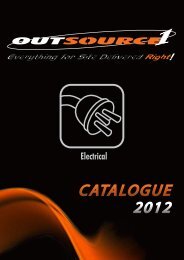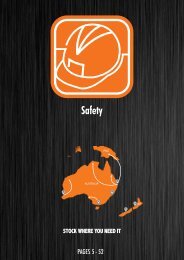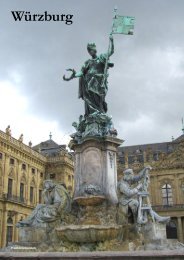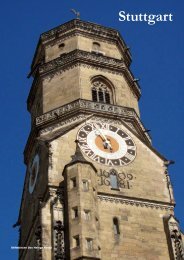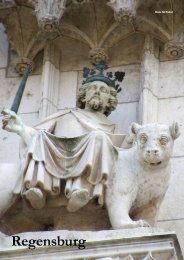Raven Guides: Germany - Trier
- No tags were found...
Create successful ePaper yourself
Turn your PDF publications into a flip-book with our unique Google optimized e-Paper software.
The Dommusik <strong>Trier</strong> program (www.<br />
dommusik-trier.de) stages choral, organ<br />
and ensemble concerts in the Dom St Peter<br />
throughout the year, including free Saturday<br />
concerts during Advent.<br />
The online ticket portal under the Events<br />
menu at the Tourist Information <strong>Trier</strong> website<br />
has a full program of regional concerts and<br />
other live shows with ticket sales links.<br />
Food<br />
There is indoor and outdoor service at<br />
Zum Christophel (tel 0651-9794200) at<br />
Simeonstraße 1 beside the Porta Nigra with<br />
an offering of house specialities between €10<br />
and €20 and set menus up to €30, along with a<br />
wine selection.<br />
Zum Domstein (M-Su 8.30-24, tel 0651-<br />
74490) at Hauptmarkt 5 offers the German<br />
restaurant feel with the standards at €14-20 per<br />
course (children’s meals available).<br />
Meet & drink<br />
The pubs and cafes of the narrow Judengasse<br />
through the archway off Hauptmarkt are<br />
favourite spots and there is plenty of outdoor<br />
service on Hauptmarkt and Simeonstraße in<br />
summer.<br />
A village feel is a feature of Zurlauben<br />
north of the Altstadt, with a river aspect along<br />
Zurlaubener Ufer ideal for outdoor enjoyment.<br />
Accommodation<br />
To survey and book accommodation, including<br />
private rooms, visit the tourist website<br />
www.trier-info.de and use the Accommodation<br />
menu. Budget rooms can also be searched<br />
online at www.deutsche-pensionen.de/<br />
pension-trier. <strong>Trier</strong> has a hotel tax of €1.07 per<br />
person, generally included in listed prices.<br />
Hotel Vinum (tel 0651-994740, ekkt.<br />
ekir.de/trier/1451.0.html) is opposite the<br />
Hauptbahnhof at Bahnhofsplatz 7 with<br />
singles/doubles/triples from €56/87/107 in<br />
high season, €51/82/102 low season including<br />
breakfast, full facilities and WLAN to rooms.<br />
The hotel is non-smoking and allergy-free<br />
rooms are available.<br />
The medium-sized three-star Hotel Casa<br />
Chiara (tel 0651-270730, www.casa-chiara<br />
.de) is only 200m from the Porta Nigra but in a<br />
quiet street at Engelstraße 8 with high-season<br />
singles/doubles/triples from €65/95/150 (this<br />
is cheaper Sundays), low season €55/75/140.<br />
Parking is available. Take buses 2, 3, 4, 12 or<br />
13 to Porta Nigra.<br />
The small family-run Hotel Pieper (tel<br />
0651-23008, www.hotel-pieper-trier.de) is<br />
300m north of the city centre at Thebäerstraße<br />
39 with a restaurant downstairs and singles/<br />
doubles/triples including breakfast at €55/<br />
85/120. The walk is 400m north-west from<br />
the Hauptbahnhof via Moltkestraße from the<br />
north end of the Bahnhofsplatz.<br />
Hotel Deutschherrenhof (tel 0651-<br />
97542, www.hotel-deutschherrenhof-trier<br />
.de) is two minutes’ walk from the city<br />
centre at Deutschherrenstraße 32, offering<br />
singles/doubles with breakfast from €55/75<br />
in high season, €50/55 low season, family<br />
rooms from €130 and €110. WLAN access<br />
is free but parking is extra. Take bus 2 to<br />
Deutschherrenstraße.<br />
Hotel Garni Grund (tel 0651-25939),<br />
only 150m from Porta Nigra at Paulinstraße<br />
7, offers singles/doubles/triples with breakfast<br />
and full facilities from €40/70/96. Secure<br />
The Baroque facade of the Karl-Marx-Haus<br />
(1727) at Brückenstraße 10, birthplace of the<br />
founder of socialism, had to be restored in the<br />
1930s after intervening changes. The rear parts<br />
of the building date from the 19th century but<br />
there is also an arcaded gallery overlooking<br />
the inner courtyard, a feature of a moderately<br />
affluent middle-class town house, although the<br />
interiors are not preserved. The building is also<br />
the museum of the political economist’s life and<br />
ideas – as well as the critical contribution of his<br />
collaborator Friedrich Engels – and explores<br />
aspects of his legacy (see Museums). Take bus<br />
2, 6, 7, 13, 15, 40 to Karl-Marx-Haus.<br />
The Römerbrücke (c150) over the Moselle is<br />
<strong>Germany</strong>’s oldest bridge and the oldest of Roman<br />
bridges north of the Alps. In the Roman period<br />
it led to the Porta Inclyta, the west city gate. It<br />
displays the remains of three separate building<br />
stages: the basalt footings are largely intact but<br />
the original roadway was wooden and the stone<br />
arches go back to the 14th century. These had to<br />
be rebuilt early in the 18th century after a 1689<br />
assault by the French army. At this stage the St<br />
Nicholas statue and crucifix were added but the<br />
bridge towers were torn down in the 19th century.<br />
The statue of Constantine on the east bank is<br />
Baroque. Take bus 1, 4 or 10 to Römerbrücke.<br />
Today fenced off but revealed by<br />
19th century archaeological excavations,<br />
foundations and underground systems of<br />
the two Barbarathermen 2nd century<br />
baths are visible near the corner of<br />
Friedrich-Wilhelm-Straße and Südallee.<br />
What is exposed today includes tunnels,<br />
canals and furnaces and some decoration<br />
and finds are preserved in the Rheinisches<br />
Landesmuseum (see Museums). The<br />
complex, which originally measured<br />
almost 250m by 180m, was used until the<br />
5th century but surviving buildings served as a castle in medieval times and thereafter<br />
much of the remains was reused for building. Take bus 1, 10 or 40 to Barbarathermen.<br />
The Mariensäule (1866) stands on the cliffs of the<br />
Markusberg above the wooded east bank of the Moselle.<br />
The Catholic citizens of <strong>Trier</strong> raised it in celebration of the<br />
Immaculate Conception, asserted in a papal bull of 1854,<br />
largely in defiance of the rule of Protestant Prussia and<br />
perhaps spurred by the recent remaking of the<br />
Konstantin-Basilika as an Evangelical church. The statue<br />
of Mary, designed by Gottfried Renn on a Neogothic pillar<br />
partly of recycled Roman sandstone, reaches 40m from the<br />
highest point in the area. The site, reached by a pathway<br />
off Auf der Jüngt, is in an area that offers the best lookout<br />
over the city and Moselle valley. Take bus 10 to Auf der<br />
Jüngt or Mariensäule.<br />
Two cranes on the Moselle east bank are<br />
monuments to the ancient river traffic.<br />
The stone Gothic Krahnen (or Alter<br />
Kran, 1413) near the end of<br />
Krahnenstraße is one of <strong>Germany</strong>’s<br />
oldest. Some of its machinery including a<br />
treadmill wheel is just visible inside. The<br />
boom is of oak. The Roman harbour was<br />
probably in this area as wharf storehouses<br />
(horrea) were on the site of the former<br />
convent St Irminen. To the south is the<br />
Zollkran (1774), which stayed in use until<br />
almost World War I. Take bus 1, 4 or 10<br />
to Römerbrücke.<br />
<strong>Trier</strong> 6 - RAVEN TRAVEL GUIDES GERMANY








